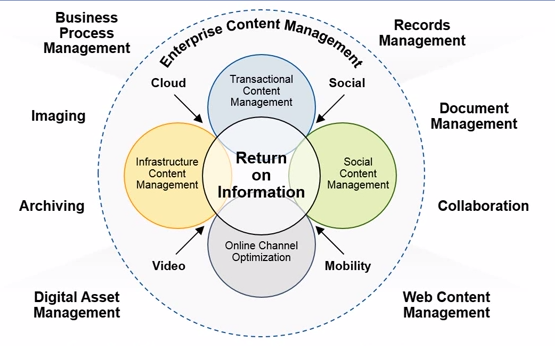Enterprise Content Management is the organizational process methodology which is designed for the content life cycle management.
The enterprise content management solutions enable the organization for taking the full advantage of the customer information and then engage them via content. It also helps in automating the business process and enhancing collaboration.
How ECM works?

ECM has 5 elements called as store, capture, secure, retrieve, and automate. The purpose of each element is as follows:-
Capture: It captures the essential data and documents into the system. Some of the strategies to capture documents is to include the utilization of the electronic forms for making digital documents. Scanning the paper documents for filing in a digital repository. Managing digital content such as photos, PDFs, Microsoft Office documents, videos, etc., and categorizing documents automatically from servers and shared locations.
Store: Companies can preserve the business document in a digital repository allowing users to view document metadata, arrange documents in a structured folder, and view document in the repository. ECM eliminates cost, time, and difficulties in handling the documents.
Retrieve: After storing records, you can identify the phrase or keywords within document text, annotations, metadata, and entry names for finding the document that can utilize the full-text search. The software reduces the time spent for searching data and answering queries of the citizens, customers, etc.
Automate: The process helps companies in reducing manual jobs and accomplish good results with lesser resources. It makes the system streamlined, and affordable.
Secure: It monitors document destruction and creation, password change, system login, and logout, protects sensitive metadata, and restrict access to documents.
The benefits which Enterprise Content Management software provides are:
1) Ensures integrated compliance with the industry and government regulations.
2) Reduces costs through decreased storage space.
3) Cost effective document management control
4) Secures functions which filters sensitive data thus facilitating document sharing
5) Reduces IT resources through SaaS solutions
The basic features which an Enterprise Content Management system should have are:
1) Central repository: It simplifies your file sharing by handling multiple file formats which can be in paper or electronic format.
2) Document scanning: It eases the file sharing process and retrieval with different methods of scanning the documents.
3) Securing email files: ECM ensures that it can be easily integrated into the popular email applications used by the organization.
4) Mobile accessibility: One can access the data from anywhere at any time. It can be through Android, smartphone, iPad, tablets, and iPhone. This increases productivity and efficient operating process.
5) Cloud-based accessibility: ECM offers cost-effective storage from anywhere thus building up a great connectivity procedure.

